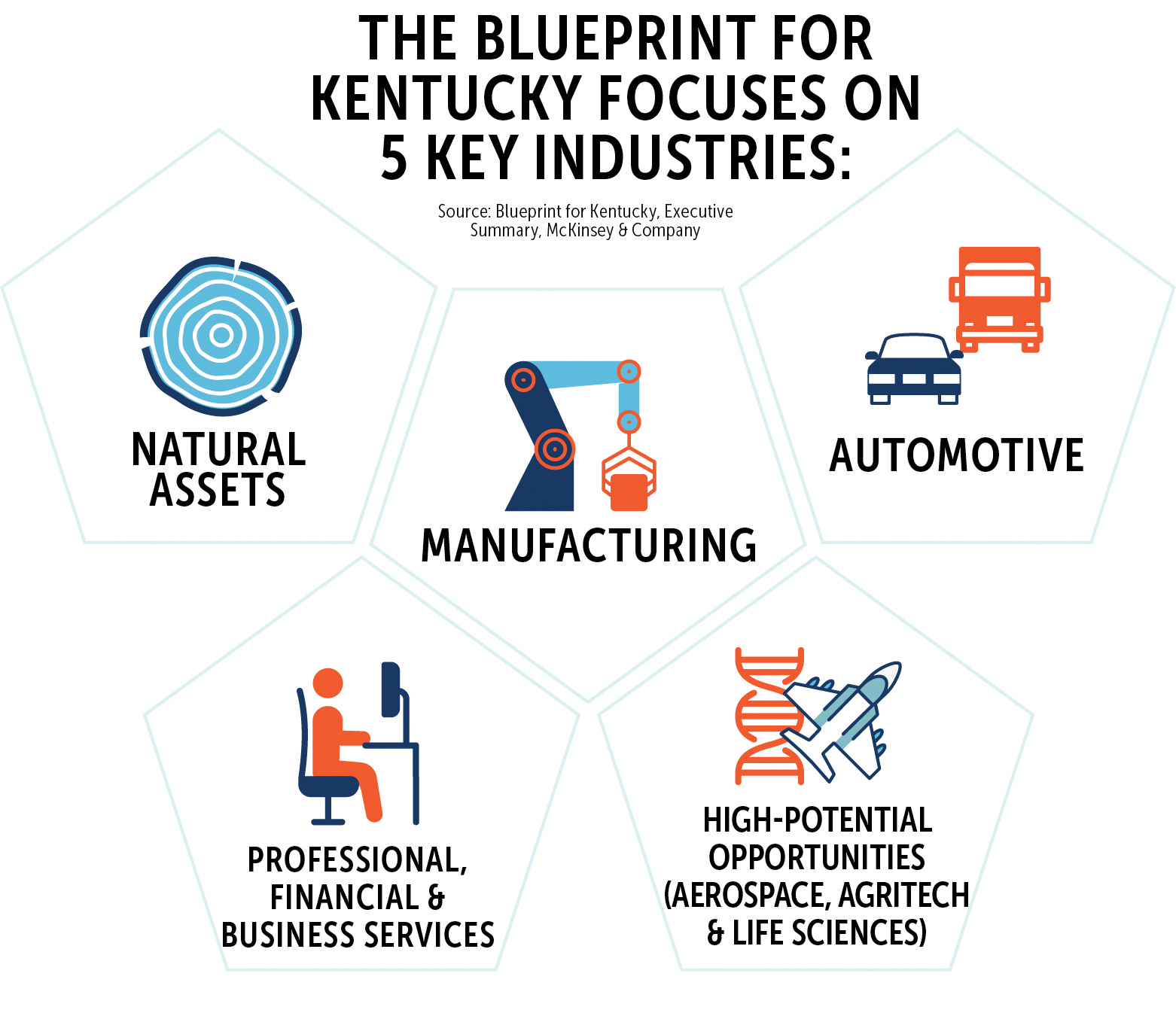 Economies are in transition, which creates opportunities. And to sustain the historic surge of billions in business investment the past few years, state and local officials are betting better teamwork is their best strategy to keep up the win streak.
Economies are in transition, which creates opportunities. And to sustain the historic surge of billions in business investment the past few years, state and local officials are betting better teamwork is their best strategy to keep up the win streak.
Getting it right could lock in higher Kentucky incomes and quality of life across the state.
The strategy—called “Collaborative Blueprint”—aims to improve efficiency and outcomes within today’s decentralized framework, where there are fewer economic developers in Frankfort and more at work across Kentucky’s 120 counties and hundreds of communities.
Its focus is collaboration: more of it, more often, with better data and understanding about what every community, county and region has to offer, and finding opportunities to bring the elements together. Rather than a state of many economic silos, the goal is to merge into one bigger, stronger operation.
It’s been in the works since Cabinet for Economic Development Secretary Jeff Noel and Gov. Andy Beshear first explored ideas some two years ago when Noel was interviewing to come to Frankfort for his current job. A Kentucky native, Noel had worked in the cabinet in the 1990s when it had twice the staff of today but was away in Michigan nearly 30 years working in economic development with Whirlpool Corp. and local and state agencies there.
In the past four years, Kentucky has had $30.3 billion in announced investments from more than 1,000 private-sector new and expansion projects, creating more than 52,000 jobs. Those are the best figures for any four years in commonwealth history and include the largest projects ever.
Kentucky has earned a status as the U.S. electric vehicle battery production capital with Ford Motor Co. and SK On’s $5.8 billion, 5,000-job BlueOval SK Battery Park in Hardin County; AESC’s $2 billion, 2,000-job gigafactory project in Warren County; Toyota’s $1.3 billion battery vehicle assembly investment in Scott County; Ascend Elements’ $1 billion, 400-job battery recycling and precursor materials manufacturing plant in Christian County; and INFAC North America’s $53 million investment in Taylor County, among others.
Billion-dollar public infrastructure and private multiuse development projects are active in Northern Kentucky and Louisville, which each have massive logistics hubs at their airports. The bourbon industry has billions in growth underway.
“There is no denying the incredible economic success we have had over the past four years, with the most private-sector investment of any administration and several of the largest job-creation projects on record,” Gov. Andy Beshear said. “But we recognize there is still so much more we can achieve as a state, and the Collaborative Blueprint will help us navigate our future.”
To keep up that flow of investment and job creation, in February the Cabinet for Economic Development unveiled a framework and process for the state economic development community to share information on Kentucky’s collective strengths with all participants in the grow-the-state-economy community.
The goal was to improve the process rather than create a new plan. The state’s request for proposals emphasized this, Noel said, after initial planning in the cabinet and input from key players such as the Kentucky Association for Economic Development, the Kentucky Chamber of Commerce, and the Kentucky Association of Manufacturers. Global management consultant McKinsey & Co. was chosen to craft the specifics.
The result is a blueprint to collaborate more effectively and get more investments and more jobs with higher incomes.
There are concrete goals for those wins, too, Noel said. These include:
- $7.5 billion in investment annually
- 12,000 new jobs annually
- Pay of $27 an hour or better from those jobs
The improved process steps include pushing out specific data on the state’s diverse industry sectors, natural resources, quality of life, cost of living and doing business, workforce and training, education and other support. Working from common facts and one playbook, development community members in each of five state regions will have structured meetings at least three times a year to collaborate with one another, with prospects and with diverse project participants.
The plan is called the Collaborative Blueprint “to drive home the point that we are all in this together,” Noel said. Silos of information and operation stymie the work.
When they talk about the newly unveiled blueprint, economic development officials out in the state already talk enthusiastically about how much face-to-face interaction they had with cabinet staff as the plan took shape.
“They were very, very proactive,” said Amanda Davenport, executive director of Lake Barkley Partnership in Western Kentucky and chair of the KAED board. “The goal was to continue to build on the momentum that we have seen in the past few years. How do we continue to be proactive so that we compete at a national level, and what tools do the economic developers need to ensure that they are prepared to compete for those projects?”
Having the blueprint and its specifics will make it easier for local economic developers to get needed political and financial support from local judge-executives, fiscal courts, mayors and city councils, Davenport said.
More communication will lead to more ideas about how Kentucky communities can help each other—by teaming up when there are common strengths to combine, by sharing best practices and solutions for common problems, by becoming sales agents for one another via letting prospects know about other Kentucky sites, incentives or opportunities.
 Information is power. And it can keep today’s project pipeline producing for tomorrow, ensuring that the information is spread into every corner of the state.
Information is power. And it can keep today’s project pipeline producing for tomorrow, ensuring that the information is spread into every corner of the state.
The goal of the Collaborative Blueprint is to generate extensive engagement across the commonwealth’s economic development community in the next five years to increase opportunities for all Kentuckians and to attract others to invest, work, live and recreate in the commonwealth and its communities.
It sets five objectives to guide the journey:
- Inclusive growth across all of Kentucky’s 120 counties.
- High-quality jobs that pay a family-sustaining wage.
- An environment that grows, attracts and retains businesses—small, medium and large.
- Welcoming and diverse communities where people from across the country will want to build their homes and the future for their families.
- Opportunities for Kentuckians to grow, develop and create their own destinies.
The blueprint calls for the next five years’ economic development focus to begin with five existing priority sectors where Kentucky has proven success and baseline capabilities. Economic developers will be leveraging traditional tools such as industrial site development while collaborating with diverse stakeholders.
Kentucky’s five priority
sectors are:
- Automotive: Win further by assisting the evolution of Kentucky’s automotive base while strategically investing for growth in high-potential sectors (e.g., electric vehicles).
- Manufacturing: Be a leader in the U.S. manufacturing renaissance by helping Kentucky’s sector navigate successful transitions in their industries and become a destination of choice for next-generation industry-leaders.
- Natural assets:
Capitalize on what makes Kentucky unique, from its lakes, natural resources and cultural tourism to distribution and logistics, using targeted infrastructure investments and regional strategies.
- Business, financial and professional services:
In a growing category, capture Kentucky’s fair share of tomorrow’s jobs in professional services. That includes enhancing rural remote work opportunities and partnering with existing anchor institutions to expand their footprint.
- High-potential industry clusters:
Support high-growth and high-potential opportunities in life sciences, agritech and aerospace with targeted local strategies to bring together private companies, research and academic institutions, and commercialization assets.
An additional five areas support the commonwealth’s economy in a cross-cutting manner by “enabling” the growth and performance of Kentucky’s priority sectors. The alignment on priority sectors will thus help focus efforts within and across these enablers. Economic developers will help lead on defining and advocating for the right kind of “competitive products,” such as sites and incentives for the priority sectors. At the same time, economic developers will play a more supportive role—as collaborators, conveners and catalysts for action—for the priority enablers where other stakeholders have the skills, expertise, organizations and resources to lead.
Kentucky’s five priority enablers are:
- Competitive sites:
Invest in strategic sectors by aligning the state’s incentives toolkit with priority sectors and developing a portfolio of sites with sector-specific attributes across all regions.
- Workforce:
Partner to develop, energize and support the workforce of the future by bringing employers “to the table” and working closely with workforce partners to set strategic priorities for talent development.
- Catalyze entrepreneurism and innovation ecosystems:
Build Kentucky’s reputation as
a “make and ideate,” “launch-ready” state by nurturing local growth, entrepreneurial niches, and being a more welcoming landing pad for domestic and global startups and capital.
- Infrastructure:
Incorporate the voice of industry into infrastructure priorities and coordinate economic development activities with infrastructure investments.
- Placemaking:
Create community and business collaboration to build welcoming, inclusive and diverse communities by mobilizing local private and civic leaders across all industries, especially tourism.
Major economic development leaders around the state are unanimous in their support for the plan.
“We firmly believe the state’s collaborative approach will empower all stakeholders to help carry out these ambitious goals,” said Sarah Davasher-Wisdom, CEO/president of Greater Louisville Inc.

BE NKY Growth Partnership also actively participated in the process, said Lee Crume, CEO/president.
“With the blueprint, BE NKY will be more innovative and collaborative with the state, communities, regional groups, and other economic development stakeholders,” Crume said. “We will utilize the Blueprint’s research for the state’s target clusters to inform our business attraction work for Northern Kentucky.”
Fayette County and the Greater Lexington region recently conducted a similar process to update its own strategic targets, which align with the Collaborative Blueprint, said Commerce Lexington CEO/President Bob Quick.
“Our team is also working on a talent attraction campaign to bring more skilled workers to the nine-county region to support our targeted industries. We will be working with the state on similar workforce attraction efforts,” Quick said. “States are in fierce competition for people—without the workers, it becomes more difficult to land the jobs.”
SPEDA, the economic development agency for Somerset/Pulaski County participated in the cabinet’s advisory panel as well, said SPEDA CEO/President Chris Girdler.
“Collaboration and communication are key to our success as a community as well as a state as a whole,” Girdler said. “I anticipate that while this lays out a great plan for the future, it may be a fluid document per se, adjusting to fit the needs of certain communities and regions



















